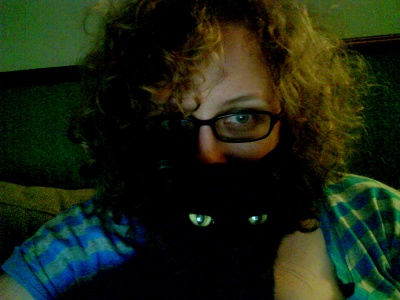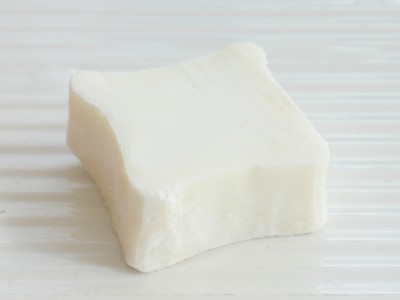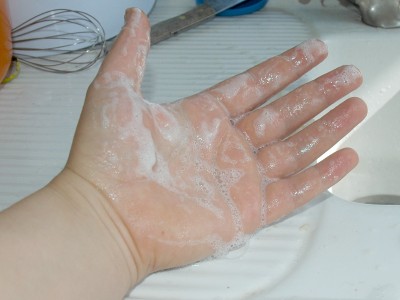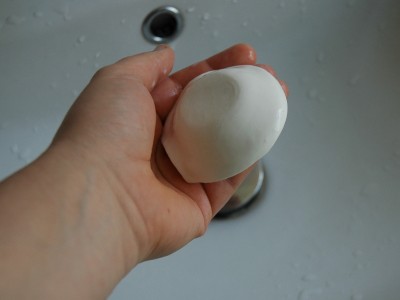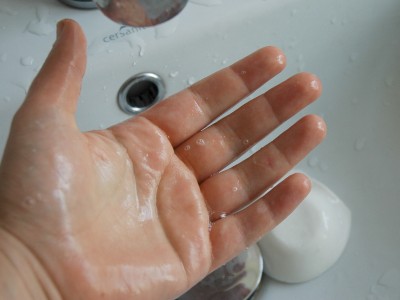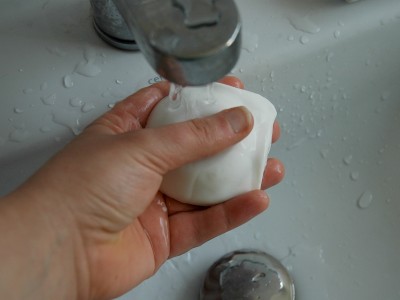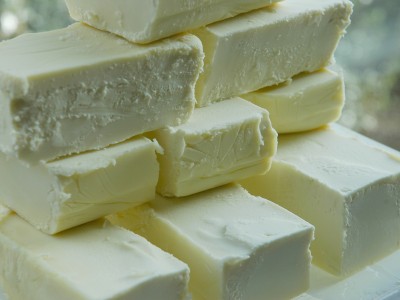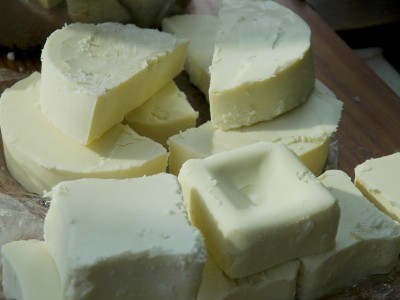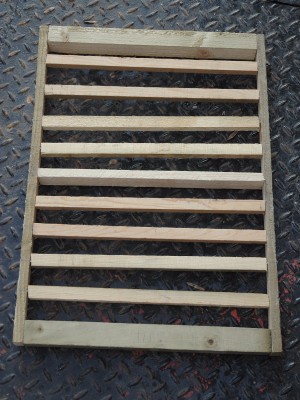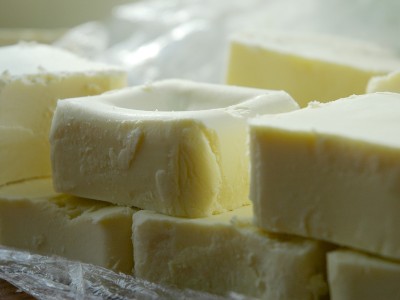Soap-making questions – can you help?
Two people have asked me soap-making questions on Twitter this afternoon and I thought I’d post them over here as well because I know that not everyone is a Twit.
Firstly, Clare of Three Beautiful Things asked:
Do you have any soap cutting tips, please? I’ve just bought a large block and don’t want it to crumble when I slice it.
I couldn’t help with this one – my soap is still a little soft when I cut it so crumbling isn’t an issue. When my first batch was a bit harder, it did crumble a bit under the knife but I just accepted the rough edged soap bars and collected the crumbles for use as laundry/household soap. Any advice to avoid the crumbles in the first place though?
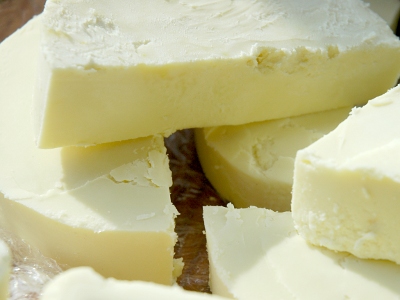
@AlisonJFews replied:
Don’t know about cutting it, but need a really good soap supplies website. With the one I chose, you had to spend £25 + a time!
And again, I couldn’t help! The soap I’ve made has always been from supermarket supplies and I’ve used misc things as moulds so I’ve not had to use any soap making supplies websites for specialist oils, fats or what-have-you.
For people like me who like to use what’s easily on hand, Sharon of SmithyCraft sent us this link for working out how much lye to use – thanks Sharon.
Has anyone else got any advice/ideas for the other questions?
(By the way, this has reminded me that I’ve been sent a soapmaking ebook to read and review – I’ll get that done this week!)
Read MoreTen things
- Buff the chicken has been in isolation since last Wednesday since the others started really *viciously* bullying her (as I said on Twitter, it’s disturbing how vicious chickens can be). I think there have been pecking order issues over the last few weeks and it’s stopped her being able to eat properly. She feels very bony (even for a pure breed) and is weak as a result – looking back at old photos of her, the difference is stark. I’m hoping some time by herself and some special food will turn her around but I wouldn’t be surprised to go down one morning to find she’d died overnight. Sigh.
- We painted the bathroom on Sunday – not the woodwork yet but the second coat of the walls, ahead of the cupboards being fitted tomorrow. One June mini goal down (nearly)!
- In other housey news, last year we found a hidden coal hole at the front of our house and over the last couple of weeks, we’ve been having it damp-proofed and turned into a utility room. It’s not been cheap but now has a proper full height doorway and is a proper extra room for the house – it’ll free up room in the kitchen too. It should be finished this week, hurrah!
- While that’s going on at great expense inside, John’s DIY-mad dad is fitting a fence for us outside — to help contain the dog and the chickens a bit more. The fence is going to be rather frugal for a new fence as the lumberyard John’s dad goes to was throwing away about 20 horizontal fencing beams and some posts, because they’d got slightly bleached in the sun so couldn’t be sold “as new” any more. Madness! But useful timing for us!
- And speaking of freebies, someone was taking a seemingly brand new electric staple gun in its case at the tip last time John’s dad was visiting – they told him it was “broken” but he took it home and found they’d just inserted the staplers in the wrong place. We now have a brand new working electric staple gun for free ;)
- I never used to use bar soap to wash anywhere other than my hands – it left a film and dried my skin, causing my face in particular to get greasier in compensation. But my olive oil soap leaves my skin clean and soft – and it stays feeling that way for 12+ hours unlike just about every other cleaning method I’ve tried. I very much like it.
- I made the ugliest soda bread I’ve ever made today – I don’t know what went wrong but it grew really unevenly. Still tasted lovely with soup for lunch though :)
- Some of my rapini has gone to seed – the heads weren’t big enough to warrant harvesting. Damn the hot spring!
- Do you make your own quiches? I’m looking for (frugal) store-cupboard recipe quiche ingredient ideas for when we’ve not got much else in — Viksterbean on Twitter suggested antipasti such as olives and artichokes, and that made me think about adding a swirl of pesto too. Any other ideas?
- Boron would like it to be known that I did not write this post alone. Apologies for the poor quality of my webcam – I only ever use it for these type of pics ;) Read More
Using our 100% vegetable oil soap
You may remember a few months ago I spent a bajillion hours waiting for some 100% olive oil soap to reach trace then, as a glutton for punishment, I decided to make a second batch of another 100% vegetable oil soap the same day.
We started using the 100% olive oil soap and have got through a few small bars of it – John likes it a lot. He likes that it doesn’t lather much (as it, conversely, encourages him to use less of it) and it doesn’t smell perfumed either (he hates perfumed things).
In a “why change what’s working?” way, we hadn’t tried the other set of soap – the 100% veg oils one – but I decided that should change this week!
The non-lye ingredients of the 100% olive oil one are pretty obvious – the 100% veg oil one a little more complicated — but still, everything bought from the supermarket. I used Frugal Queen’s recipe and method – olive oil, sunflower oil and Cookeen (solid veg shortening) – just leaving out the scent. It traced faster than the olive oil one thankfully!
The resulting soap is softer than the 100% olive oil one (apparently that’s down to the veg shortening) and not quite as pale – a soft lemon-ish colour. (It had some soap ash on it when I first picked it out of its drying place, which I’ve mostly scrapped off – hence the not-perfectly-smooth edges and slight colour variation on the before use picture above). It lathers quite a bit more than the olive oil soap – not crazy commercial soap levels but noticeably more. It did feel more like shop bought soap though – leaving my skin feeling a little “squeaky”. That’s not necessarily a bad thing, just a thing.
I spent £5.27 on the ingredients (£1.89 on the olive oil [on offer at Netto at the time], £1.06 on the sunflower oil, £1.43 on the shortener and £0.89 for the caustic soda needed for this recipe – based on a 500g bottle from Wilkinsons; and I used tap water and no scent) – which I think out frugals the Frugal Queen ;) I ended up with 2850g of finished soap – the bars were randomly sized but if they were normal 100g-ish bars, that would be about 19p a bar (or about 24p a bar if they’re 125g, which was the weight I used to work out the per-bar cost of the 100% olive oil ones [35p]).
As I said regarding the 100% olive oil ones, I’m not sure I enjoyed the process enough to do it often but I like the idea of making a big batch every six months/year as necessary. Before the next batch though, I’m going to try handmilling some of the ones from this batch to try out different (frugal, supermarket-sourced) scents – and might try turning a bar into liquid soap too as that’s handy when my hands are filthy from gardening.
Has anyone else made the Frugal Queen’s 100% veg oil soap? What did you think of it? Or do you have any 100% supermarket-sourced veg oil soaps? Or suggestions for frugal scents and any handmilling/liquid-soap-from-bar making advice?
Read MoreUsing our homemade olive oil soap
Last week, we started using our homemade olive oil soap.
You might remember I spent A MILLION HOURS waiting for the damn thing to trace back in February but didn’t think it would work because it was sloppy in the moulds for a few days. Then it started to solidify and I did a happy dance.
So, anyway, after a few more weeks of curing/drying, we started using it last week. I went with one of the 100% olive oil ones, not the one-third olive oil, two-thirds other veg oils (more on those later when we try them).
I was really paranoid at first – worried it would be too caustic or something – so made sure to scrap off the bits of white powder (soda ash) from the edges, rather than just washing it off. Cavitch’s troubleshooting guide says to beware of “excessive” white powder as that can indicate too much lye or hard water has been used – but I don’t think my white powder was “excessive”, just some.
The soap is very pale – almost pure white. Apparently the better quality of olive oil, the paler the resulting soap. My olive oil (which came from Netto) claimed to be extra virgin so this fits. It has quite a neutral smell – slightly olive oil-ish but nowhere near as strong as the olive oil I started with. It’s pretty hard now and doesn’t lather much at all – but that’s expected with pure olive oil soap and the latter isn’t a huge problem as it’s not like we’ll be using it as shaving soap or anything like that.
So anyway, the verdict. It feels nice to use – smooth and silky, and no alkaline burns at all – always a good thing in a soap ;). Because of the play and stuff last week, I haven’t actually got my hands that dirty since we started using the soap so can’t comment on the actual cleaning properties but it leaves my skin feeling clean – and … not “squeaky”. I don’t know how to describe it but whenever I usually use normal bar soap, my skin feels “squeaky” afterwards – presumably either dryness or some sort of residue. That isn’t a problem with our olive oil soap – even when I washed them five times in a row to double-triple-quintiple check that it wasn’t too caustic (yes, really overly paranoid).
As I said explained in my last soap post, we’re not interested in pretty or pleasantly perfumed soaps – we want them to clean us, be long lasting, to have an inoffensive smell, create minimal waste and be frugal. The hardness of this soap means it doesn’t turn to mush in the soap dish and the only waste produced were two plastic bottles (which can be recycled – but one of which was actually reused as a soap mould first).
As for the frugalness, I had used this recipe and method which called for 1 litre of olive oil, 126g of caustic soda and 300g of water. I paid £2.52 for the olive oil from Netto, about £1.50 (I’ve lost the receipt!) for 500g of caustic soda from Wilkinsons (so about 38p for the amount I used) and tap water (which is effectively free), so the consumables cost around £2.90 for the batch. (I did buy a pan and steel dish to use too – but they’ll be used again for soap making and other non-foody pursuits (such as dyeing) so I considered them a general craft supply costs rather than including them in these figures.)
Weighing it just now, I’ve got around 1050g of dried, ready-to-use soap – or 35p per 125g bar — my bars differ in sizes (from about 50g, for the ones from the fruit tray mould – as seen in the pictures – to about 125g for ones shaped in an old mini roaster tray) but that’s the size of a bar of Oliva soap, which is the 100% olive oil soap we’d used previously, so is a good comparison. Oliva usually costs about £1 a bar.
All in all, I’m glad I tried it and I’m very happy with the result – but it was a bit of a faff. I think I did the right thing by processing two loads of soap on the same day so made economies of scale re: faffiness. Hopefully the soap we’ve got now will last us about a year – I’d happily do it once every six months or a year but I couldn’t be bothered doing it much more frequently than that.
Read MoreSoap making book reviews: Soapmaking by Sarah Ade and The Natural Soap Book by Susan Miller Cavitch
Ahead of making soap for the first time a fortnight ago, I bought and read two soap making books – I thought it would be best to get familiar with the techniques before I started playing with burn-your-flesh lye.
The books I bought were:
- ‘Soapmaking’ by Sarah Ade, part of the New Holland Self-Sufficiency series, and,
- ‘The Natural Soap Book: Making Herbal and Vegetable-based Soaps’ by Susan Miller Cavitch
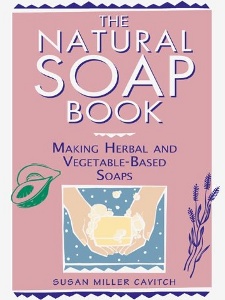 Both came with glowing reviews on Amazon but, to be frank, neither book particularly did it for me. I spent a lot of time looking for what I thought would be the most suitable books but still, I may have had overly high expectations or completely wrong ones so I’ll start with some positives of both before I start with my criticisms.
Both came with glowing reviews on Amazon but, to be frank, neither book particularly did it for me. I spent a lot of time looking for what I thought would be the most suitable books but still, I may have had overly high expectations or completely wrong ones so I’ll start with some positives of both before I start with my criticisms.
Both are nice books to look at and easy to read. ‘The Natural Soap Book’ is particularly lovely – it’s printed in a lovely purple font on soft cream paper, with clear, relevant line illustrations. There is a lot of text in it – considerably more than ‘Soapmaking’ – but there is still enough “whitespace” to make it pleasant to read and not feel cluttered or dense.
Both books include pages on soap-making history & theory, useful information on the chemistry of soap making (saponification charts etc) and the characteristics of different oils/butters, and scents and other (natural) addictives. ‘The Natural Soap Book’ went a bit further, as you may expect from a more advanced book, but ‘Soapmaking’ provided a decent amount of information too.
But (and this is where the criticisms start) for all their talk about different soaps and oils/butters, the recipes seem lacking in variety. All but one recipe in each book contains olive oil, palm oil and coconut oil – not just in there a little bit, but the majority (fat) ingredients in every case. Now I know the authors are both experienced soap makers and I’m not so perhaps I’m wanting something that’s stupid, but I’d have liked different types of soap mentioned – a 100% olive oil recipe (since that was one of reasons I started looking at making soap), or some without palm oil or without coconut oil, or heck, without olive oil. It felt like there was a basic recipe that they always used (admittedly perhaps with good reason) and the only different thing was the essential oils or the odd bit of some special oil (‘Soapmaking’ was particularly guilty of this – they felt very much variations on a theme except for the liquid soap recipe in the “taking soap further” section).
Read MoreMy first soap
I made some soap for the first time last week. It took FOREVER to trace. I wrote a blog post about that but didn’t explain any more about my soap making because, well, frankly, at that point, it looked like it was going to be a big fat fail.
Even though it had reached what could be considered trace, it still felt very sloppy when I was pouring it into the moulds and even overnight and over the next night, it was harder but still very soft. The directions I’d read had said to take it out of the moulds after a couple of days – mine would have still blobbed all over the place at that point. But it clearly was still curing and it was more than ready to leave the moulds today – a week after it was made. (It was probably ready for tipping out by Wednesday – it was a lot paler and seemed like it would hold its shape – but I was just busy with other stuff so thought it would be better to leave it rather than rush it.)
I made two batches – I’ll post the recipes & cost breakdown once I know that it is actually a success and they’re good to use but for now, I’ll say the first was a 100% olive oil soap, and the second was a third olive oil and two-thirds other generic veg oils/shortening — everything bought from supermarkets. As I’ll explain more when I review the two soap-making books I bought, we’re pretty utilitarian when it comes to our soaps – we want them to get us clean, to not be harsh & drying, and to smell alright. We want them to create minimal waste & be as frugal as possible. This is particularly important for me while I’m learning the skills – if I make a mistake, it’s nothing more than a few quid and some time; if I was buying neem oil, shea butter and essential oils, I’d not only be paying more for the ingredients, I’d be paying for postage & packing too and having to wait for them to arrive too.
As expected, the 100% olive oil soap is considerably paler & already harder than the mixed oils one – the veg shortening keeps it that bit softer. Because I ended up making a lot more than I’d intended in one day, I had to get a bit more creative about the moulds than I thought I would at the start. The 100% soap used an old plastic fruit tray & an old deep oven tray as moulds.
The mixed oil one got the choicest mould – a long flat tray with a lid (from when we bought a big pack of ostrich burgers from the farmers market) – but its overflow containers weren’t as suitable really – one of the square olive oil bottles and an ice cream bucket. They were more awkward to use but have resulted in interesting shaped soaps.
Once I’d popped everything out and cut it to size, I thought “I’ll put this in the airing cupboard to keep curing and drying for the next few weeks”. Then I had a “doh!” moment – the airing cupboard got pulled out by our bathroom refitters on Monday! I hadn’t acted quick enough to keep the racks I’d made which would have been perfect as drying racks (I did though save the cupboard doors – one of which I used as a chopping board for the soap, and the others will make a raised bed). So anyway, I needed something to use for drying racks so yet again, I raided the scrap wood store and twenty minutes later:
A drying rack! It’s a very rough & ready job, done without any measuring hence the slats being a bit wonky, but it’ll do fine for this purpose.
Now the soap is on the new rack drying in the attic room. I guess I shouldn’t declare it a resounding success just yet until it’s finished and we can try it, but after a few days of foreboding failure, it looks a lot more hopeful now!
Read More


